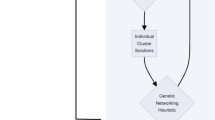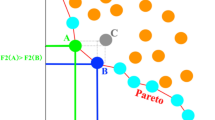Abstract
This paper deals with some new operators of genetic algorithms and demonstrates their effectiveness to the traveling salesman problem (TSP) and microarray gene ordering. The new operators developed are nearest fragment operator based on the concept of nearest neighbor heuristic, and a modified version of order crossover operator. While these result in faster convergence of Genetic Algorithm (GAs) in finding the optimal order of genes in microarray and cities in TSP, the nearest fragment operator can augment the search space quickly and thus obtain much better results compared to other heuristics. Appropriate number of fragments for the nearest fragment operator and appropriate substring length in terms of the number of cities/genes for the modified order crossover operator are determined systematically. Gene order provided by the proposed method is seen to be superior to other related methods based on GAs, neural networks and clustering in terms of biological scores computed using categorization of the genes.
Similar content being viewed by others
References
Larranaga P, Kuijpers C, Murga R, Inza I, Dizdarevic S (1999) Genetic algorithms for the traveling salesman problem: a review of representations and operators. Artificial Intell Rev 13:129–170
Garey MR, Johnson, DS (1979) Computers and intractability: a guide to the theory of NP-completeness. W. H. Freeman and Co., San Francisco
Goldberg DE (1989) Genetic algorithm in search, optimization and machine learning, Machine Learning, Addison-Wesley, New York
Tsai CF, Tsai CW, Yang T (2002) A modified multiple-searching method to genetic algorithms for solving traveling salesman problem. In: IEEE int conf systems, Man and cybernetics, vol. 3, pp 6–9
Jiao L, Wang L (2000) A novel genetic algorithm based on immunity. IEEE Transactions on Systems, Man and Cybernetics, Part A 30(5):552–561
Ray SS, Bandyopadhyay S, Pal SK (2004) New operators of genetic algorithms for traveling salesman problem. Cambridge, UK, ICPR-04 2:497–500
Fiechter CN (1994) A parallel tabu search algorithm for large traveling salesman problems. Discrete Appl Math Combin Oper Res Comput Sci 51:243–267
Zachariasen M, Dam M (1995) Tabu search on the geometric traveling salesman problem. In: Proc. of int conf on metaheuristics, pp 571–587
Potvin JY (1993) The traveling salesman problem: a neural network perspective. ORSA J Comput 5:328–348
Bai Y, Zhang W, Jin Z (2006) An new self-organizing maps strategy for solving the traveling salesman problem. Chaos, Solitons & Fractals 28(4):1082–1089
Stutzle T, Dorigo M (1999) ACO algorithms for the traveling salesman problem, evolutionary algorithms in engineering and computer science. John Wiley and Sons
Lin S, Kernighan BW (1973) An effective heuristic for the traveling salesman problem. Oper Res 21(2):498–516
Helsgaun K (2000) An effective implementation of the Lin-Kernighan traveling salesman heuristic. Eur J Oper Res 1:106–130
Applegate D, Cook W, Rohe A (2000) Chained Lin-Kernighan for large traveling salesman problems. Tech Rep Dept Comput Appl Math Rice Univ
Gamboa D, Rego C, Glover F (2006) Implementation analysis of efficient heuristic algorithms for the traveling salesman problem. Computers & Operations Res 33(4):1154–1172
Tsai HK, Yang JM, Tsai YF, Kao CY (2004) An evolutionary algorithm for large traveling salesman problems. IEEE Transactions on Systems, Man and Cybernetics, Part B: Cyebernetics 34(4):1718–1729
Reinelt G (1994) The traveling salesman: computational solutions for TSP applications. Lecture notes in computer science, Springer-Verlag 840
Bentley JL (1992) Fast algorithms for geometric traveling salesman problems. ORSA J Computing 4(4):387–411
Johnson DS, McGeoch LA (1996) The traveling salesman problem: a case study in local optimization. Local search in combinatorial optimization. Wiley and Sons, New York
Davis L (1985) Applying adapting algorithms to epistatic domains. In: Proc. int. joint conf. artificial intelligence, Quebec, canada
Oliver I, Smith D, Holland J (1987) A study of permutation crossover operators on the traveling salesman problem. Second int. conf. genetic algorithms, pp 224–230
Starkweather T, McDaniel S, Mathias K, Whitley D, Whitley C (1991) A comparison of genetic sequencing operators. 4th Int. conf. genetic algorithms, pp 69–76
Whitley D, Starkweather T, Fuquay D (1989) Scheduling problems and traveling salesman: the genetic edge recombination operator. 3rd Int. conf. genetic algorithms, pp. 133–140
Homaifar A, Guan S, Liepins G (1993) A new approach on the traveling salesman problem by genetic algorithms. 5th Int conf genetic algorithms, pp 460–466
Biedl T, Brejov B, Demaine ED, Hamel AM, Vinar T (2001) Optimal arrangement of leaves in the tree representing hierarchical clustering of gene expression data. Tech Rep 2001–14, Dept Computer Sci., Univ. Waterloo
Spellman PT, Sherlock G, Zhang MQ, Iyer VR, Anders K, Eisen MB, Brown PO, Botstein D, Futcher B (1998) Comprehensive identification of cell cycle-regulated genes of the yeast saccharomyces cerevisia by microarray hybridization. Molecular Biology Cell 9:3273–3297
Eisen MB, Spellman PT, Brown PO, Botstein D (1998) Cluster analysis and display of genome-wide expression patterns. In: Proc. national academy of sciences, vol. 95, pp 14863–14867
Tamayo P, Slonim D, Mesirov J, Zhu Q, Kitareewan S, Dmitrovsky E, Lander ES, Golub TR (1999) Interpreting patterns of gene expression with self-organizing maps: methods and application to hematopoietic differentiation. In: Proc. national academy of sciences, pp 2907–2912
Tsai HK, Yang JM, Kao CY (2002) Applying genetic algorithms to finding the optimal gene order in displaying the microarray data. GECCO, pp. 610–617
Lee SK, Kim YH, Moon BR, (2003) Finding the Optimal Gene Order in Displaying Microarray Data. GECCO, pp. 2215–2226
Applegate D, Bixby R, Chvtal V, Cook W (2003) Concorde package. [online]. www.tsp.gatech.edu/concorde/downloads/codes/src/co031219.tgz.
TSPLIB, http://www.iwr.uniheidelberg.de/groups/comopt/software/TSPLIB95/.
Website, http://www.psrg.lcs.mit.edu/clustering/ismb01/optimal.html.
Author information
Authors and Affiliations
Corresponding author
Additional information
Shubhra Sankar Ray is a Visiting Research Fellow at the Center for Soft Computing Research: A National Facility, Indian Statistical Institute, Kolkata, India. He received the M.Sc. in Electronic Science and M.Tech in Radiophysics & Electronics from University of Calcutta, Kolkata, India, in 2000 and 2002, respectively. Till March 2006, he had been a Senior Research Fellow of the Council of Scientific and Industrial Research (CSIR), New Delhi, India, working at Machine Intelligence Unit, Indian Statistical Institute, India. His research interests include bioinformatics, evolutionary computation, neural networks, and data mining.
Sanghamitra Bandyopadhyay is an Associate Professor at Indian Statistical Institute, Calcutta, India. She did her Bachelors in Physics and Computer Science in 1988 and 1992 respectively. Subsequently, she did her Masters in Computer Science from Indian Institute of Technology (IIT), Kharagpur in 1994 and Ph.D in Computer Science from Indian Statistical Institute, Calcutta in 1998.
She has worked in Los Alamos National Laboratory, Los Alamos, USA, in 1997, as a graduate research assistant, in the University of New South Wales, Sydney, Australia, in 1999, as a post doctoral fellow, in the Department of Computer Science and Engineering, University of Texas at Arlington, USA, in 2001 as a faculty and researcher, and in the Department of Computer Science and Engineering, University of Maryland Baltimore County, USA, in 2004 as a visiting research faculty.
Dr. Bandyopadhyay is the first recipient of Dr. Shanker Dayal Sharma Gold Medal and Institute Silver Medal for being adjudged the best all round post graduate performer in IIT, Kharagpur in 1994. She has received the Indian National Science Academy (INSA) and the Indian Science Congress Association (ISCA) Young Scientist Awards in 2000, as well as the Indian National Academy of Engineering (INAE) Young Engineers' Award in 2002. She has published over ninety articles in international journals, conference and workshop proceedings, edited books and journal special issues and served as the Program Co-Chair of the 1st International Conference on Pattern Recognition and Machine Intelligence, 2005, Kolkata, India, and as the Tutorial Co-Chair, World Congress on Lateral Computing, 2004, Bangalore, India. She is on the editorial board of the International Journal on Computational Intelligence. Her research interests include Evolutionary and Soft Computation, Pattern Recognition, Data Mining, Bioinformatics, Parallel & Distributed Systems and VLSI.
Sankar K. Pal (www.isical.ac.in/∼sankar) is the Director and Distinguished Scientist of the Indian Statistical Institute. He has founded the Machine Intelligence Unit, and the Center for Soft Computing Research: A National Facility in the Institute in Calcutta. He received a Ph.D. in Radio Physics and Electronics from the University of Calcutta in 1979, and another Ph.D. in Electrical Engineering along with DIC from Imperial College, University of London in 1982.
He worked at the University of California, Berkeley and the University of Maryland, College Park in 1986-87; the NASA Johnson Space Center, Houston, Texas in 1990-92 & 1994; and in US Naval Research Laboratory, Washington DC in 2004. Since 1997 he has been serving as a Distinguished Visitor of IEEE Computer Society (USA) for the Asia-Pacific Region, and held seve ral visiting positions in Hong Kong and Australian universities. Prof. Pal is a Fellow of the IEEE, USA, Third World Academy of Sciences, Italy, International Association for Pattern recognition, USA, and all the four National Academies for Science/Engineering in India. He is a co-author of thirteen books and about three hundred research publications in the areas of Pattern Recognition and Machine Learning, Image Processing, Data Mining and Web Intelligence, Soft Computing, Neural Nets, Genetic Algorithms, Fuzzy Sets, Rough Sets, and Bioinformatics.
He has received the 1990 S.S. Bhatnagar Prize (which is the most coveted award for a scientist in India), and many prestigious awards in India and abroad including the 1999 G.D. Birla Award, 1998 Om Bhasin Award, 1993 Jawaharlal Nehru Fellowship, 2000 Khwarizmi International Award from the Islamic Republic of Iran, 2000–2001 FICCI Award, 1993 Vikram Sarabhai Research Award, 1993 NASA Tech Brief Award (USA), 1994 IEEE Trans. Neural Networks Outstanding Paper Award (USA), 1995 NASA Patent Application Award (USA), 1997 IETE-R.L. Wadhwa Gold Medal, the 2001 INSA-S.H. Zaheer Medal, and 2005-06 P.C. Mahalanobis Birth Centenary Award (Gold Medal) for Lifetime Achievement .
Prof. Pal is an Associate Editor of IEEE Trans. Pattern Analysis and Machine Intelligence, IEEE Trans. Neural Networks [1994–98, 2003–06], Pattern Recognition Letters, Neurocomputing (1995–2005), Applied Intelligence, Information Sciences, Fuzzy Sets and Systems, Fundamenta Informaticae, Int. J. Computational Intelligence and Applications, and Proc. INSA-A; a Member, Executive Advisory Editorial Board, IEEE Trans. Fuzzy Systems, Int. Journal on Image and Graphics, and Int. Journal of Approximate Reasoning; and a Guest Editor of IEEE Computer.
Rights and permissions
About this article
Cite this article
Ray, S.S., Bandyopadhyay, S. & Pal, S.K. Genetic operators for combinatorial optimization in TSP and microarray gene ordering. Appl Intell 26, 183–195 (2007). https://doi.org/10.1007/s10489-006-0018-y
Published:
Issue Date:
DOI: https://doi.org/10.1007/s10489-006-0018-y




